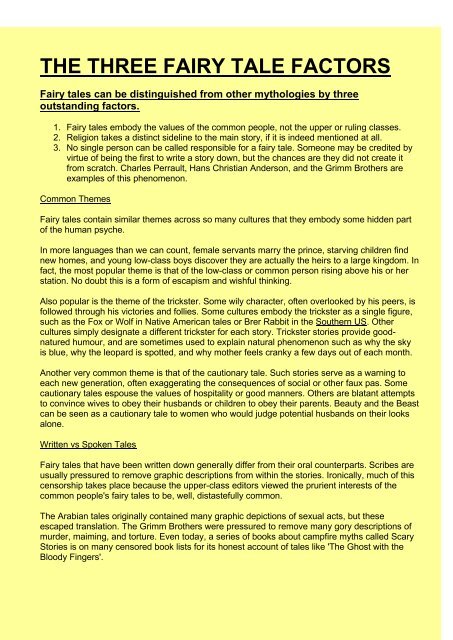HOW TO WRITE BETTER FAIRY TALES - DEAN AMORY
Complete course on writing Fairy Tales (aka Wonder Tales)
Complete course on writing Fairy Tales (aka Wonder Tales)
You also want an ePaper? Increase the reach of your titles
YUMPU automatically turns print PDFs into web optimized ePapers that Google loves.
THE THREE <strong>FAIRY</strong> TALE FAC<strong>TO</strong>RS<br />
Fairy tales can be distinguished from other mythologies by three<br />
outstanding factors.<br />
1. Fairy tales embody the values of the common people, not the upper or ruling classes.<br />
2. Religion takes a distinct sideline to the main story, if it is indeed mentioned at all.<br />
3. No single person can be called responsible for a fairy tale. Someone may be credited by<br />
virtue of being the first to write a story down, but the chances are they did not create it<br />
from scratch. Charles Perrault, Hans Christian Anderson, and the Grimm Brothers are<br />
examples of this phenomenon.<br />
Common Themes<br />
Fairy tales contain similar themes across so many cultures that they embody some hidden part<br />
of the human psyche.<br />
In more languages than we can count, female servants marry the prince, starving children find<br />
new homes, and young low-class boys discover they are actually the heirs to a large kingdom. In<br />
fact, the most popular theme is that of the low-class or common person rising above his or her<br />
station. No doubt this is a form of escapism and wishful thinking.<br />
Also popular is the theme of the trickster. Some wily character, often overlooked by his peers, is<br />
followed through his victories and follies. Some cultures embody the trickster as a single figure,<br />
such as the Fox or Wolf in Native American tales or Brer Rabbit in the Southern US. Other<br />
cultures simply designate a different trickster for each story. Trickster stories provide goodnatured<br />
humour, and are sometimes used to explain natural phenomenon such as why the sky<br />
is blue, why the leopard is spotted, and why mother feels cranky a few days out of each month.<br />
Another very common theme is that of the cautionary tale. Such stories serve as a warning to<br />
each new generation, often exaggerating the consequences of social or other faux pas. Some<br />
cautionary tales espouse the values of hospitality or good manners. Others are blatant attempts<br />
to convince wives to obey their husbands or children to obey their parents. Beauty and the Beast<br />
can be seen as a cautionary tale to women who would judge potential husbands on their looks<br />
alone.<br />
Written vs Spoken Tales<br />
Fairy tales that have been written down generally differ from their oral counterparts. Scribes are<br />
usually pressured to remove graphic descriptions from within the stories. Ironically, much of this<br />
censorship takes place because the upper-class editors viewed the prurient interests of the<br />
common people's fairy tales to be, well, distastefully common.<br />
The Arabian tales originally contained many graphic depictions of sexual acts, but these<br />
escaped translation. The Grimm Brothers were pressured to remove many gory descriptions of<br />
murder, maiming, and torture. Even today, a series of books about campfire myths called Scary<br />
Stories is on many censored book lists for its honest account of tales like 'The Ghost with the<br />
Bloody Fingers'.


















